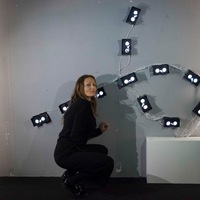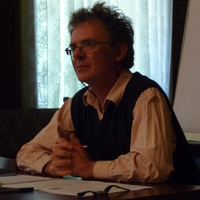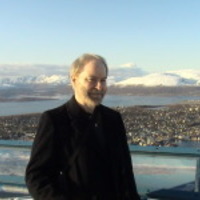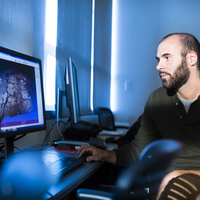
Chiara Passa
Chiara Passa - visual artist, working in media art since 1996
http://www.chiarapassa.it/Artisticprofile.html
http://www.chiarapassa.it/SelectedExhibitions.html
http://www.chiarapassa.it/Artisticprofile.html
http://www.chiarapassa.it/SelectedExhibitions.html
less
Related Authors
Galen Strawson
The University of Texas at Austin
Steven Pinker
Harvard University
Beat Signer
Vrije Universiteit Brussel
Pau Alsina
Universitat Oberta de Catalunya
Pier Giuseppe Monateri
Università degli Studi di Torino
David Seamon
Kansas State University
Romy Golan
Graduate Center of the City University of New York
Shaun Gallagher
University of Memphis
Armando Marques-Guedes
UNL - New University of Lisbon
Fabrizio Galeazzi
Anglia Ruskin University
InterestsView All (24)










Uploads
Books by Chiara Passa
From the Book: “L’elettronica è donna” edited by Castelvecchi, Roma 2022. Cod. 9788832905694
space and create site-specific meshes all over the real place. Meanwhile the meshes' vertices generate a
series of randomly nomadic objects growing up from the wall and the floor chunks.
Depth Data Space is an augmented reality application using pre-trained AI algorithms that interpret real
space to design a structure made of points cloud surrounding the tangible situ. Through AI the real-time
depth buffer turns into nano-sculptures that, seen all together, design a Big Data Space always different
according to the real piece/space that it will cover.
Due to the incessant and fast-paced upgrades internet is subject to, many web-based art projects risk digital oblivion. Ideasonair by Chiara Passa sets out to be a restoration project of a net artwork that for seven years existed in the form of a blog. Starting specifically from her work, this book grapples with many of the questions circulating among those dealing with digital art, its conservation, and its spread. Essays by Alessandro Alfieri, Laura Barreca, Valentino Catricalà, Elena Giulia Rossi, Antonello Tolve and Chiara Passa herself, explore contemporary and cross-sectional subjects touching on aesthetics, media theories, art critique and philosophy: from digital art conservation to the transmedial nature of ideas, and from heterotopic memory spaces set between reality and virtuality to ideas converted into software objects.
The book (ENG.): https://en.silvanaeditoriale.it/libro/9788836649112
ITA: https://www.silvanaeditoriale.it/libro/9788836649112
_code.art_ con Arcángel Constantini, Joan Leandre y Brian Mackern
y
Al otro lado (to the other side) con 0100101110101101.ORG, Teresa Arozena, Juan Domingo, Fernando Llanos, Carlos Nieto, Xavier Monsalvatje, Óscar Mora, Francis Naranjo, Antonio Ortuño, Chiara Passa, Tania Sanjurjo y Andrés Senra.
Y la net.jamm de Arcángel Constantini, Fernando Llanos y Brian Mackern celebrada en el W Seoul Walkerhill Hotel. Seúl —Corea del Sur. 12.004
Chiara Passa (Rome, 1973) is a visual artist who has worked in Media Art since 1997. Over the course of the past two decades, Passa has been investigating space in all its features and forms creating animations, online works, interactive installations, and projects that use augmented and virtual reality as creative tools and distinctive viewpoints to analyze space in all its various facets.
(Ital.) Indirizzato a studiosi e curiosi che si vogliano addentrare nelle nuove trasformazioni della tecnologia e dello spazio attraverso l’occhio dell’arte, questo volume nasce per disegnare l’ampia ricerca di Chiara Passa, artista che ha attraversato i più grandi cambiamenti degli ultimi tempi, dalla fine degli anni Novanta ad oggi. Voltarsi indietro e ripercorrere con Object Oriented Space vent’anni di progetti e idee significa, non solo rileggere i punti cardinali di un percorso pionieristico nel campo della New Media Art, ma anche ritracciare e riesaminare le grandi trasformazioni del progresso tecnologico legato oggi alle ultime frontiere della filosofia ontologica, proiettate verso una visione post-antropogenica.
Chiara Passa (Roma, 1973) è un’artista visiva che lavora dal 1997 nell’ambito Media Art. Nel suo percorso ormai ventennale ha indagato lo spazio in tutte le sue estensioni e forme realizzando animazioni, opere web, installazioni interattive, progetti di realtà aumentata e virtuale come strumenti creativi e punti di osservazione privilegiati per analizzare lo spazio nelle sue diverse sfaccettature.
Papers by Chiara Passa
Inside the Geometry - double language, is a virtual reality project, which takes the form of various site-specific immersive art-installations watchable from more than 20/30 persons at the same time thanks to the use of multiple Google Cardboards (the 3D viewers for practice with mobile devices to experience virtual reality), plus diverse smartphones playing all different VR animations. For Inside the Geometry - double language, the Google Cardboards are arranged in the exhibition space to orchestrate on the walls, or from the ceiling a series of geometric designs conceived for all occasions (examples of the images and video links below). By peeking through the 3D viewers, the audience can take a journey beyond the wall, beyond physical space, diving into the liquid dimension of wired geometries. I use the 3D viewers as an artistic medium to interrogate outer spaces beyond walls and architecture. Inside the Geometry - double language challenges architecture to render it vibrant and participatory. It is through audience experience that Inside the Geometry - double language addresses people to the paradox of the modern space-time condition, even more diluted between physical and liquid space. In my works, where VR simulates a purely intuitive space, the onlookers become blind and hyper-seeing at the same time. Blind, because we lose all the Cartesian reference points of reality, and hyper-seeing space because we finally find ourselves completely immersed and involved in the artwork, no longer limiting ourselves to mere observation. In fact, through VR the onlookers can hyper-enjoy the artwork by passing through it and penetrating its most intimate place of origin. Typically, the 3D viewers are installed all over the real space, designing geometric shapes in liminal areas where onlookers can peek through the 3D viewers, over the wall, to immerse themselves into a re-constructed/resized VR space made of wired geometric angles and futuristic views. The whole Virtual Reality series (more than 35 VR figures created since 2015 till now) is part of a research project which I began in 2015 (the year when the 3D viewers became commercially and arrived to us) and which slots into my artistic journey since 1997, the fruit of a deep interest in space and how it is transformed and shaped through the language of informatics. In software and electronic devices, I find potential vehicles for the investigation and visualization of my artistic research and theories. My immersive works behave as if they were “alive”, moving “beyond their own functionality”. These are “super places”, as I defined already in 1999, dynamic places which project the spectators into digital and mediated realities.
Talks by Chiara Passa
Object Oriented Stones is a series of interactive 3D sculptures viewable through virtual and mixed reality. The immersive artwork shows an alternative and visionary side of the stones, which appear animated by a sort of bizarre nature, transforming beyond their own functionality into something colored and unpredictable that melt with the scenario that turns into an always new one. Object Oriented Stones is an immersive experience where spectators are welcome to enter in the middle of nowhere and cross an abstract forest to find, transform and interact with the ten stones, plus the whole forest-scenario that changes alongside the objects when manipulated and shifted all around. Once grabbed, the stones emit sonorities while generating a particle system designed by their own shapes exchanging and mixing meshes and textures between each other and melting with the scenario to design a new object-oriented atmosphere all around the audience.
Video sneak-peek: https://www.youtube.com/watch?v=aAH9TKCgbYY
"Null Void 0" AR-AI conceptual and minimalist wall-drawings exploring the theme of emptiness and the potential for creation with it. The AR-AI artwork is a sort of 'impossible puzzle' where the audience is called to play a game within the intent of reconstructing the real 3D shape of the mural-artwork. "Null Void 0” invites the audience to traverse the border between art and game, by exploring the oscillations between tangible and virtual place.
To interact with the AI-AR wall drawing, there will be two QR codes to scan for downloading the Apps (IOS, Android) to augment the wall-drawing. Audience by tapping on the phone/tablet screen, generates the solids (more than 100) which compose the 3D artwork. Each piece can be scaled, translated and rotated while emitting an AI (random generated) spoken phrase which speculates on the computer vision practice and the object-recognizes AI model. In fact, most of the time, the AR/AI App won't recognize the specific solid/part of the wall drawing shape, inventing a new meaning for it and causing unexpected and weird shifts of senses on its own shape. I trained the AI on the Object Oriented Ontology philosophy and minimalism/conceptual art stuff. "Null Void 0" is part of “Live Architectures”, a series of phygital artworks I started in 1999 to render places and architecture alive and vibrant over its functionality.
Video sneak-peeks:
https://www.youtube.com/watch?v=uOKUwPgsMMg (Villa Bottini, Parma 2024) http://oplineprize.com/en/edition-en-2024/artists-2024/chiara-passa-en/ (Null Void 0 received the Opline Prize during the Nuite Blanche in Paris, 2024) https://www.youtube.com/watch?v=HZ5bK_o3R_E (Panke gallery, Berlin 2023) https://www.youtube.com/watch?v=o4IhEptaeO0 (Museum MLAC, Roma 2019)
Android App: https://play.google.com/store/apps/details?id=com.ChiaraPassa.NullVoid
IOS App: https://apps.apple.com/us/app/null-void-0/id6445810431
From the Book: “L’elettronica è donna” edited by Castelvecchi, Roma 2022. Cod. 9788832905694
space and create site-specific meshes all over the real place. Meanwhile the meshes' vertices generate a
series of randomly nomadic objects growing up from the wall and the floor chunks.
Depth Data Space is an augmented reality application using pre-trained AI algorithms that interpret real
space to design a structure made of points cloud surrounding the tangible situ. Through AI the real-time
depth buffer turns into nano-sculptures that, seen all together, design a Big Data Space always different
according to the real piece/space that it will cover.
Due to the incessant and fast-paced upgrades internet is subject to, many web-based art projects risk digital oblivion. Ideasonair by Chiara Passa sets out to be a restoration project of a net artwork that for seven years existed in the form of a blog. Starting specifically from her work, this book grapples with many of the questions circulating among those dealing with digital art, its conservation, and its spread. Essays by Alessandro Alfieri, Laura Barreca, Valentino Catricalà, Elena Giulia Rossi, Antonello Tolve and Chiara Passa herself, explore contemporary and cross-sectional subjects touching on aesthetics, media theories, art critique and philosophy: from digital art conservation to the transmedial nature of ideas, and from heterotopic memory spaces set between reality and virtuality to ideas converted into software objects.
The book (ENG.): https://en.silvanaeditoriale.it/libro/9788836649112
ITA: https://www.silvanaeditoriale.it/libro/9788836649112
_code.art_ con Arcángel Constantini, Joan Leandre y Brian Mackern
y
Al otro lado (to the other side) con 0100101110101101.ORG, Teresa Arozena, Juan Domingo, Fernando Llanos, Carlos Nieto, Xavier Monsalvatje, Óscar Mora, Francis Naranjo, Antonio Ortuño, Chiara Passa, Tania Sanjurjo y Andrés Senra.
Y la net.jamm de Arcángel Constantini, Fernando Llanos y Brian Mackern celebrada en el W Seoul Walkerhill Hotel. Seúl —Corea del Sur. 12.004
Chiara Passa (Rome, 1973) is a visual artist who has worked in Media Art since 1997. Over the course of the past two decades, Passa has been investigating space in all its features and forms creating animations, online works, interactive installations, and projects that use augmented and virtual reality as creative tools and distinctive viewpoints to analyze space in all its various facets.
(Ital.) Indirizzato a studiosi e curiosi che si vogliano addentrare nelle nuove trasformazioni della tecnologia e dello spazio attraverso l’occhio dell’arte, questo volume nasce per disegnare l’ampia ricerca di Chiara Passa, artista che ha attraversato i più grandi cambiamenti degli ultimi tempi, dalla fine degli anni Novanta ad oggi. Voltarsi indietro e ripercorrere con Object Oriented Space vent’anni di progetti e idee significa, non solo rileggere i punti cardinali di un percorso pionieristico nel campo della New Media Art, ma anche ritracciare e riesaminare le grandi trasformazioni del progresso tecnologico legato oggi alle ultime frontiere della filosofia ontologica, proiettate verso una visione post-antropogenica.
Chiara Passa (Roma, 1973) è un’artista visiva che lavora dal 1997 nell’ambito Media Art. Nel suo percorso ormai ventennale ha indagato lo spazio in tutte le sue estensioni e forme realizzando animazioni, opere web, installazioni interattive, progetti di realtà aumentata e virtuale come strumenti creativi e punti di osservazione privilegiati per analizzare lo spazio nelle sue diverse sfaccettature.
Inside the Geometry - double language, is a virtual reality project, which takes the form of various site-specific immersive art-installations watchable from more than 20/30 persons at the same time thanks to the use of multiple Google Cardboards (the 3D viewers for practice with mobile devices to experience virtual reality), plus diverse smartphones playing all different VR animations. For Inside the Geometry - double language, the Google Cardboards are arranged in the exhibition space to orchestrate on the walls, or from the ceiling a series of geometric designs conceived for all occasions (examples of the images and video links below). By peeking through the 3D viewers, the audience can take a journey beyond the wall, beyond physical space, diving into the liquid dimension of wired geometries. I use the 3D viewers as an artistic medium to interrogate outer spaces beyond walls and architecture. Inside the Geometry - double language challenges architecture to render it vibrant and participatory. It is through audience experience that Inside the Geometry - double language addresses people to the paradox of the modern space-time condition, even more diluted between physical and liquid space. In my works, where VR simulates a purely intuitive space, the onlookers become blind and hyper-seeing at the same time. Blind, because we lose all the Cartesian reference points of reality, and hyper-seeing space because we finally find ourselves completely immersed and involved in the artwork, no longer limiting ourselves to mere observation. In fact, through VR the onlookers can hyper-enjoy the artwork by passing through it and penetrating its most intimate place of origin. Typically, the 3D viewers are installed all over the real space, designing geometric shapes in liminal areas where onlookers can peek through the 3D viewers, over the wall, to immerse themselves into a re-constructed/resized VR space made of wired geometric angles and futuristic views. The whole Virtual Reality series (more than 35 VR figures created since 2015 till now) is part of a research project which I began in 2015 (the year when the 3D viewers became commercially and arrived to us) and which slots into my artistic journey since 1997, the fruit of a deep interest in space and how it is transformed and shaped through the language of informatics. In software and electronic devices, I find potential vehicles for the investigation and visualization of my artistic research and theories. My immersive works behave as if they were “alive”, moving “beyond their own functionality”. These are “super places”, as I defined already in 1999, dynamic places which project the spectators into digital and mediated realities.
Object Oriented Stones is a series of interactive 3D sculptures viewable through virtual and mixed reality. The immersive artwork shows an alternative and visionary side of the stones, which appear animated by a sort of bizarre nature, transforming beyond their own functionality into something colored and unpredictable that melt with the scenario that turns into an always new one. Object Oriented Stones is an immersive experience where spectators are welcome to enter in the middle of nowhere and cross an abstract forest to find, transform and interact with the ten stones, plus the whole forest-scenario that changes alongside the objects when manipulated and shifted all around. Once grabbed, the stones emit sonorities while generating a particle system designed by their own shapes exchanging and mixing meshes and textures between each other and melting with the scenario to design a new object-oriented atmosphere all around the audience.
Video sneak-peek: https://www.youtube.com/watch?v=aAH9TKCgbYY
"Null Void 0" AR-AI conceptual and minimalist wall-drawings exploring the theme of emptiness and the potential for creation with it. The AR-AI artwork is a sort of 'impossible puzzle' where the audience is called to play a game within the intent of reconstructing the real 3D shape of the mural-artwork. "Null Void 0” invites the audience to traverse the border between art and game, by exploring the oscillations between tangible and virtual place.
To interact with the AI-AR wall drawing, there will be two QR codes to scan for downloading the Apps (IOS, Android) to augment the wall-drawing. Audience by tapping on the phone/tablet screen, generates the solids (more than 100) which compose the 3D artwork. Each piece can be scaled, translated and rotated while emitting an AI (random generated) spoken phrase which speculates on the computer vision practice and the object-recognizes AI model. In fact, most of the time, the AR/AI App won't recognize the specific solid/part of the wall drawing shape, inventing a new meaning for it and causing unexpected and weird shifts of senses on its own shape. I trained the AI on the Object Oriented Ontology philosophy and minimalism/conceptual art stuff. "Null Void 0" is part of “Live Architectures”, a series of phygital artworks I started in 1999 to render places and architecture alive and vibrant over its functionality.
Video sneak-peeks:
https://www.youtube.com/watch?v=uOKUwPgsMMg (Villa Bottini, Parma 2024) http://oplineprize.com/en/edition-en-2024/artists-2024/chiara-passa-en/ (Null Void 0 received the Opline Prize during the Nuite Blanche in Paris, 2024) https://www.youtube.com/watch?v=HZ5bK_o3R_E (Panke gallery, Berlin 2023) https://www.youtube.com/watch?v=o4IhEptaeO0 (Museum MLAC, Roma 2019)
Android App: https://play.google.com/store/apps/details?id=com.ChiaraPassa.NullVoid
IOS App: https://apps.apple.com/us/app/null-void-0/id6445810431